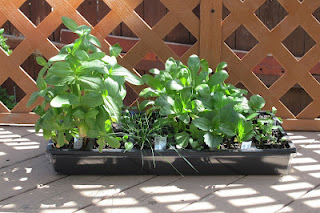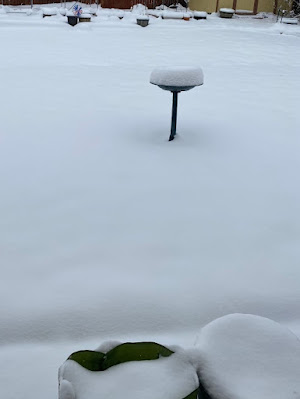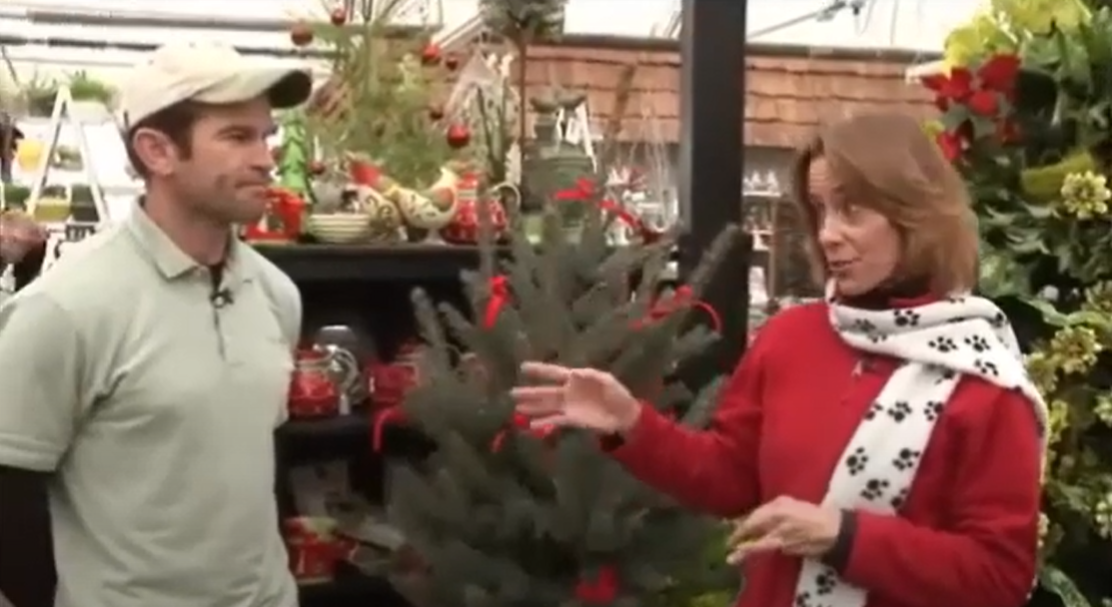Friday, December 30, 2022
Thursday, December 22, 2022
Norfolk Island Pine by Nancy Shepard
 |
| Norfolk Island Pine, Getty Images |
Norfolk Island pines are popular during the holiday season and while sometimes used as a substitute for a Christmas tree, they are not really true pines. While my childhood home in San Diego, CA has a huge 20-foot one in the backyard, here in Colorado and other colder zones they are treated like a houseplant.
Native to an island off the coast of Australia and New Zealand, Norfolk Island pines (Araucaria heterophylla) are actually not pines at all. They're a tropical plant that loves the balmy weather of the South Pacific. The Norfolk Island Pine thrives when it has conditions similar to what it would find on its home island, which means lots of bright indirect light, high humidity, and routine watering. In warm climates, the outdoor plant can reach more than 100 feet tall! Of course, when you keep them in your home, they top out around 6-feet-tall, making them a reasonably-sized tabletop or floor plant for any bright room in your house.
When it comes to decorating your Norfolk pine for the holidays, stick with lightweight Christmas decorations that won’t weigh down their slender branches. Lights are fine, too, but use LEDs, which don’t generate as much heat as traditional incandescent bulbs. After the holidays, remove the decorations and enjoy this handsome houseplant throughout the year!
High humidity is a must for the Norfolk Pine to thrive. When the humidity is not up to the Araucaria heterophylla's standards, the tips of the branches may become brown and dry. This is a houseplant that will definitely benefit from a pebble tray or placement near a humidifier.
Norfolk Island pines need at least two hours of bright, indirect sunlight daily to maintain their bright green foliage color. To ensure symmetrical, upright growth, rotate the plant weekly to keep it from permanently bending toward the light source. Temperatures of 60-72°F during the day and slightly cooler at night are optimum.
Brown branches at the bottom of the tree are normal, especially as the tree grows taller, and can be removed. Any brown branches throughout the rest of the tree are an indication that the humidity is low, or the plant needs more consistent watering.
It is possible to propagate Norfolk Island Pines from cuttings, but only cuttings taken from a terminal lead will grow in the symmetrical form that these trees are known for. Also note, that new growth will not emerge from an area that is trimmed.
Sources:
https://planttalk.colostate.edu/topics/houseplants/1321-norfolk-island-pine/
https://www.thespruce.com/grow-norfolk-island-pine-indoors-1902627
https://extension.psu.edu/norfolk-island-pines
Thursday, December 8, 2022
Do’s and Don’ts of Having a Live Christmas Tree
Luan Aikin and certified arborist Mike Landers share the do's and don'ts of having a live Christmas tree including how to bring it into the house for a brief time during the holidays and then successfully planting it. See video link below. (Originally recorded in 2012.)
https://youtu.be/-YFJTi1cdq8
Thursday, December 1, 2022
Amaryllis Bulbs for the Holidays by Vicky Spelman
Amaryllis, freesia, and paperwhite narcissus are three bulbs that don’t need to go through a chilling process to bloom. When growing amaryllis from bulbs, select large and healthy bulbs – the larger bulbs will produce more stalks and larger blooms. The bulbs should be firm and dry with no signs of mold, decay or injury.
Plant the amaryllis bulbs in containers that have a hole for drainage and are deep enough to allow for good root development. Select a container that has a diameter about 1-2 inches larger than that of the bulb. This may seem small, but amaryllis bulbs prefer a smaller container. Select a potting medium that has a high organic matter and drains well. The bulb should be planted so that one half of the bulb is above the surface of the potting medium.
 |
| Courtesy Cornell Cooperative Extension |
You can also grow the amaryllis bulbs in just water. Choose a vase – not too big around, and around 6 (+/-) inches tall, or you can get a vase especially designed for bulbs. Add pebbles (or glass marbles, etc.) not only for decoration, but to help stabilize the bulb. Trim off any dead roots, place in vase and slowly add your decorative rock. You don’t want your bulb actually touching/sitting in the water. Water as needed.
https://tinyurl.com/amaryllis-in-water
Fun Fact... To keep the stems 1/3 shorter:
Using Liquor: https://blogs.cornell.edu/hort/2009/11/10/picklin...
CSU: https://planttalk.colostate.edu/topics/houseplants/1303-amaryllis/
Cornell Cooperative Extension: https://warren.cce.cornell.edu/gardening-landscape/warren-county-master-gardener-articles/forcing-bulbs-indoors
Tuesday, November 22, 2022
Sweet Potatoes, Yams, and other Thanksgiving plants by Vicky Spelman
Wednesday, November 9, 2022
Soldiers Gardening During Wartime by Nancy Shepard
 |
| Ukrainian soldier planting potatoes in a trench in the 2022 war zone. Photo: Pravda Gerashenko |
This Friday, November 11th, is Veteran’s Day for honoring military veterans of the United States Armed Forces. I found a Jeffco CMG blog written in 2010 by Elaine Lockey that featured a book, “Defiant Gardens: Making Gardens in Wartime” by Kenneth Helphand. In the book, gardens prove to be an invaluable inspiration for people in war time. Besides the highlights of the ghetto gardens and the barbed-wire gardens of the prisoners of war and internment camps in the World Wars, soldiers themselves planted gardens in conflict war zones: the trench gardens built during WWI, Gulf War gardens built in Saudi Arabia, a base camp garden in Baghdad, Iraq, and now in in the trenches of Ukraine.
Wednesday, November 2, 2022
Leave Ornamental Grasses Alone Until Spring by Nancy Shepard
 |
| Ruby Muhly Photo: Plant Select |
As we see plants in our garden die off, some of us might
have the urge to tidy everything up. One of the plant categories that can
benefit most from a hands-off approach are the ornamental grasses.
Wednesday, October 26, 2022
Dying, off-color pine needles normal in autumn by Colorado State Forest Service
Thursday, October 20, 2022
Thursday, October 13, 2022
Fall Maintenance of Garden Tools
 |
| Photo: Pexels: Buntysmum |
While making plans to build a garden shed and taking inventory of what we want to put into it, I realized that in the twenty-plus years we’ve been in this house, I’ve always stored my garden tools outside. They have a bit of rust and the wooden handles have taken a heavy beating. Time to rescue them!
Friday, October 7, 2022
Introducing New Staff Members by Vicky Spelman
 |
| Hania Oleszak |
Wednesday, September 21, 2022
Thursday, September 15, 2022
Wednesday, August 31, 2022
Extending Your Tomatoes at the End of the Season
 |
| Photo taken October 25, 2014 by E.J. Bennet |
Speed Ripening
If you want to maximize your tomato output through the first frost, follow these steps in late August or early September to speed-ripen them on the vine:
Wednesday, August 17, 2022
Thursday, August 11, 2022
Growing Your “Third Season” Crops By Joyce D’Agostino
 |
| Leafy Greens Photo: Colorado State University |
Wednesday, August 3, 2022
My Vegetables Are Too Hot! by Nancy Shepard
 |
| Shade screen over vegie garden. Photo by Nancy Shepard |
With recent hot weather hitting 96 degrees before 10 am, I knew my vegetable garden would struggle. I remembered a presentation on growing vegetables in Colorado by Darrin Parmenter with CSU Extension in La Plata County several years ago. I was surprised to learn that tomato plants fail to produce if daytime temperatures get above 90 degrees by 10 am. He said the blossoms would abort their attempt to produce fruit. He also said that peppers were similar to tomatoes with mild peppers' optimal temperatures between 65-90 degrees and hot peppers' optimal temperatures between 75-90 degrees. And even my heat-tolerant lettuces will start to bolt and become bitter when temperatures are above 80 degrees.
Monday, July 25, 2022
Friday, July 15, 2022
Slow the Flow by Nancy Shepard
 |
| Photo: Peggychouair Pixabay |
Monday, July 11, 2022
Tips for Heat Stress in the Garden by Vicky Spelman
Wednesday, July 6, 2022
It’s Time to Arm Yourself Against Yellowjackets by Joyce D’Agostino
[Originally published June 2017]
Recently I assisted another Master Gardener at an information table at a public event. One of the people attending the event stopped by our table and saw materials about bees. She stated that she didn’t like bees and wanted none of them in her garden. One of her friends told her she was very mistaken, we all need bees to help with pollinating our gardens. This person insisted that the “bees” were very bothersome and she was concerned she could get stung. After talking with her for a few moments and asking her to describe what she was seeing, her description matched the Western Yellowjacket (Vespula spp.) Despite me telling her it wasn’t a bee, she still felt that it was part of the “bee family” and she wanted no part of any bees around her garden.
Tuesday, June 21, 2022
Summer Solstice by Vicky Spelman
Wednesday, June 15, 2022
Wednesday, June 8, 2022
Building Berms: Lessons Learned by Nancy Shepard
 |
| 2022 front yard with berm, four years after installation. Photo by Nancy Shepard |
Wednesday, May 25, 2022
Organic Gardening in a Nutshell by Amy Norwood
 |
| Organic lawn fertilizer with an OMRI logo, Photo: Amy Norwood |
Monday, May 16, 2022
My Winter-Time Master Gardener Work by Ed Powers
 |
| One of the African Violets grown in the winter enclosure. We did lose some of the violets due to the moisture level but most of them made it. |
Every late fall and winter are an interesting time for me as a Master Gardener at 8,000 feet. I enjoy gardening during the late spring and summer. My question after summer is what is next.
Wednesday, May 11, 2022
Hardening Off and Transplanting Seedlings
 |
| Photo by Brooke Coburn |
Wednesday, May 4, 2022
Drip Watering Pots and Plant Containers by Gardener Dave
Some years ago I swore off clay pots in my landscaping layout. My reason for this is: In our dry climate, small clay pots dry out “before you can put the hose away” – especially the unglazed ones. Glazed pots fare a little better, but beware of the darker colors as they absorb radiant heat and can cook plant roots if they are in full sun all day.
I still like the look of unglazed clay pots, especially in groups with the largest in the center, or large-to-small arrangement. The “Italian style” pots with the thicker rounded rims are my favorites. Hmmmm… now I’m talking about “my favorite unglazed pots”! What convinced me to use them again after I had sworn off?
Wednesday, April 27, 2022
Watch Out for Hail Season! by Joyce D'Agostino
Thursday, April 21, 2022
Earth Day 2022 by Vicky Spelman
“This is the moment to change it all — the business climate, the political climate, and how we take action on climate. Now is the time for the unstoppable courage to preserve and protect our health, our families, and our livelihoods.”
“For Earth Day 2022, we need to act (boldly), innovate (broadly), and implement (equitably). It’s going to take all of us. All in. Businesses, governments, and citizens — everyone accounted for, and everyone accountable. A partnership for the planet.” ~EarthDay.org
Wednesday, April 13, 2022
Cheap Versus Expensive Seeds by Nancy Shepard
Friday, April 1, 2022
April Fools' Day gardening... by Vicky Spelman
Some fun April Fools' Day gardening pranks...
 |
| image courtesy of Mr. Plant Geek |
Wednesday, March 23, 2022
A Different Approach to Growing Basil by Amy Norwood
 |
| Photo: Amy Norwood |
Thursday, March 17, 2022
Happy Saint Patrick's Day by Vicky Spelman
 |
| Happy Saint Patrick's Day! |
My wish for all of you!
May green be the grass you walk on!
May blue be the skies above you!
Pure be the joy that surrounds you!
True be the hearts that love you!
☘🍀☘🍀☘
May all your gardens be healthy
May all your gardens have wonderful veggies!
☘☘☘☘☘.
Monday, March 14, 2022
What Do Our Master Gardeners Grow? Part 3
Plants I'll Always Plant: Verbena bonariensis
~Master Garden Cherie
Thursday, March 10, 2022
What Do Our Master Gardeners Grow? Part 2
From Master Gardener Pam:
Plants I'll always plant: Perennials, low water, deer and rabbit resistant, attract pollinators and hummingbirds. Butterfly weed (asclepias tuberosa,) Hyssop (hyssopus officinalis,) Caryoperis, Lavender cotton (santolina chamaecyparissus,) Kannah Creek buckwheat (eriognum umbellatum v. aureum,) Penstemon, Sedum, Yarrow (achillea,) Lavender, Tickseed (coreopsis,) Salvia, Rudebeckia, Pincushion flower, Blue fescue (Festuca glauca,) Dwarf fragrant sumac (rhus aromatic,) Lemon lace elderberry (sambucus racemosa,) Hostas, Sweet woodruff (gallum ororatum,) Roses – I usually look for zone 4 or Canadian. Morden Sunrise and Dainty Bess from Hi Country Roses are favorites.
Plants I'm itching to try: Salvia ‘maraschino’, Lead plant (amorpha canescens), Englemann’s daisy (englemannia peristenia)
Forget about it: Oregano, New Mexican privet
Monday, March 7, 2022
What do our Master Gardeners grow? Part I ~your Blog Team
Thursday, March 3, 2022
Science Idea for young gardeners - beans sprouting by Vicky Spelman
Wednesday, February 23, 2022
Weather – Workin’ the Swing Shift by Patti O’Neal
[Republished from February 2011]
What is a plant to do? It’s February and all but a few plants should be peacefully enjoying the delicious dormancy of winter. In the restful sleep of hibernation each plant sends good thoughts to its root zone where precious nutrients are stored to be called on when the sunshine of spring and early summer tease them to life by warming the soil and sending messages of new growth. That’s in a perfect world. But this year as well as others we are experiencing anything but perfect.
Wednesday, February 16, 2022
Early Tree Sales are Starting Up by Nancy Shepard
 |
Tuesday, February 15, 2022
Grow This Cuke! by Amy Norwood
 |
| Salt and Pepper Cucumbers |
Several years ago, I went to a local garden store in May looking for cucumber starts. The store had two shelves full of cucumber plants, one shelf labeled “slicing” and the other labeled “pickling.” I wanted to grow cucumbers for salad, so I grabbed some plants from the slicing shelf and bought them.
When I got home, I looked at the plant tags more closely and discovered they were pickling cucumbers, a white-skinned variety called “Salt and Pepper.” Aaaaargh! Why were pickling cucumbers on the slicing shelf?
Wednesday, February 9, 2022
This is the 'Year of Salad Greens' - by Vicky Spelman
 |
| National Garden Bureau |
Get creative using the greens! Most greens can be served raw, wilted, blanched, sautéed, or grilled.
Basic Types and Variety Names...
Wednesday, February 2, 2022
Gardening Infographics by Nancy Shepard
 |
| The Ever Blooming Flower Garden by Lee Schneller 2009 |
Wednesday, January 26, 2022
2022 Landscaping with Colorado Native Plants Conference by Nancy Shepard
This year’s Landscaping with Colorado Native Plants conference is being held on Saturday, February 26th and runs 9:30 AM to 4 PM. I attended the conference last year and found it to have very valuable information and I plan on attending again. The Landscaping with Colorado Native Plants Conference promotes the inclusion of native plants in our landscaping to benefit pollinators and songbirds, save water, and restore the beauty and health of nature in the places we live, work and play.
Wednesday, January 19, 2022
Pantone's Color of the Year by Vicky Spelman
 |
| Sapphire Indigo Clematis Courtesy Star Rose and Plants |
Pantone, a globally recognized color institute, has created Very Peri (Pantone 17-3938) as its Color of the Year for 2022.
It encompasses the qualities of the blues, yet at the same time possesses a violet-red undertone for a joyous attitude and dynamic presence that encourages lots of creativity and imaginative expression. ~Pantone
We gardeners would call it periwinkle. Look for this color to show up at your local nurseries. Here are some plant ideas for incorporating this color in your garden/yard.
Wednesday, January 12, 2022
Garden Benefits of Snow By Joyce D’Agostino
 |
| Photo: Joyce D'Agostino |






























